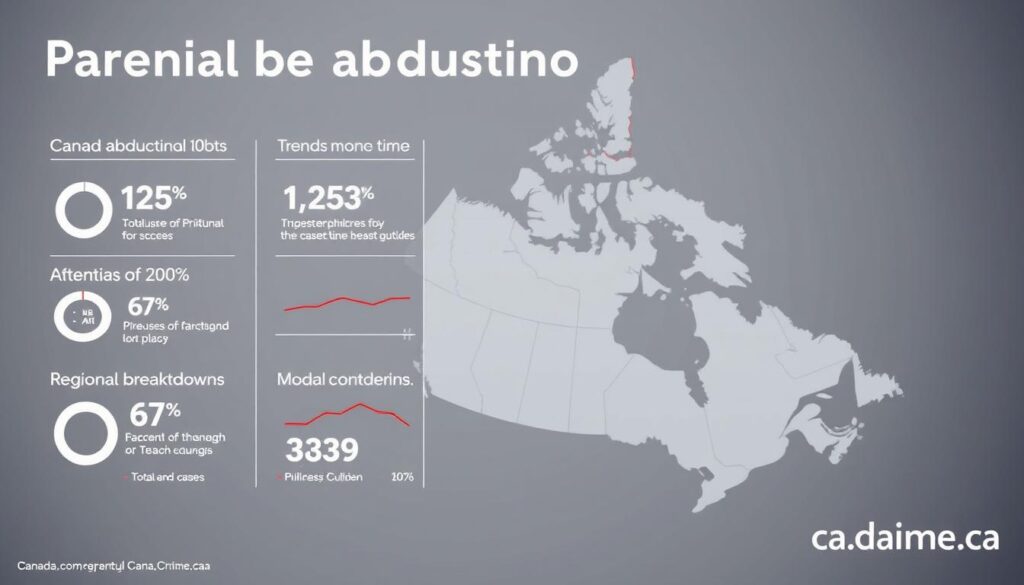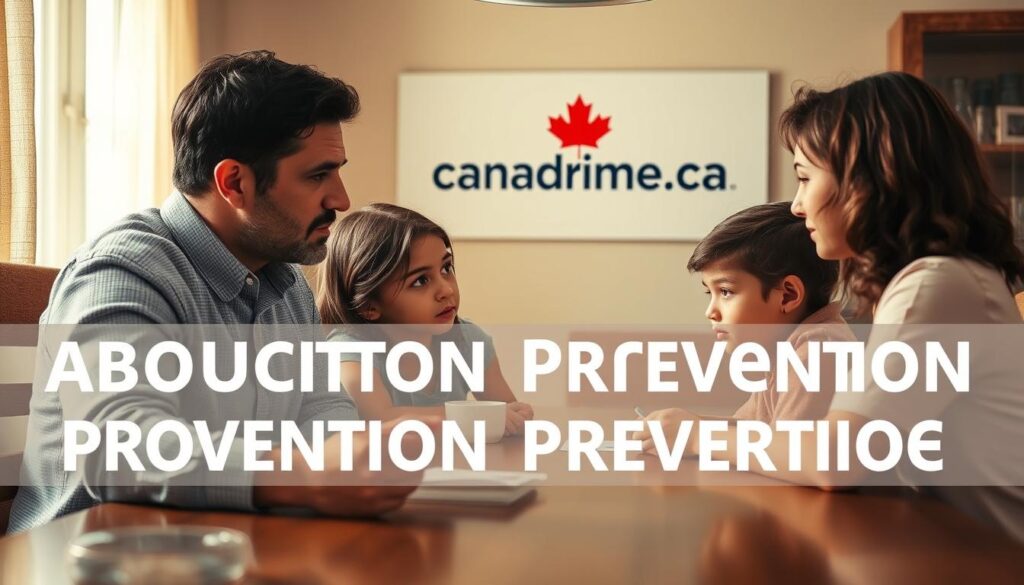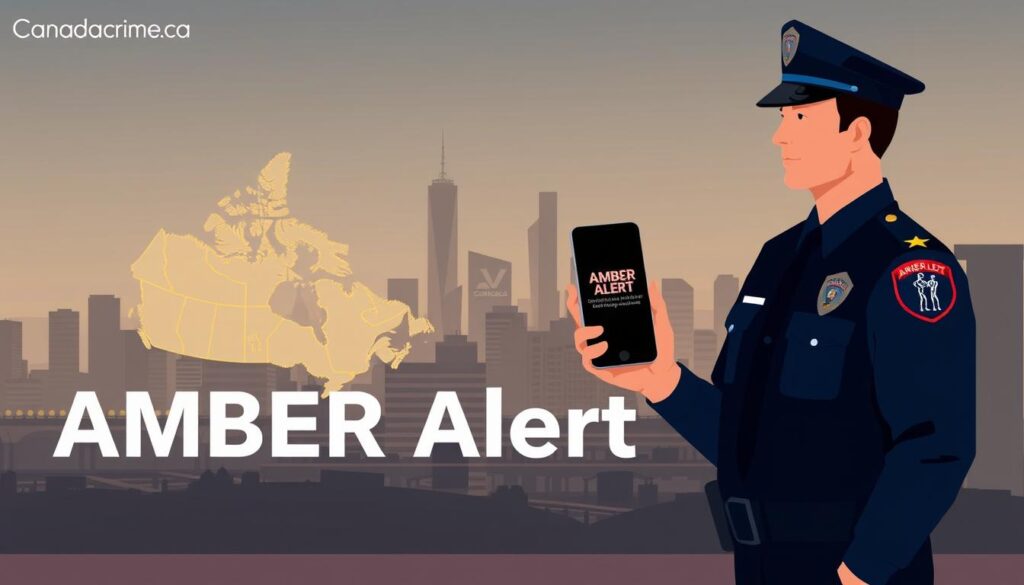Over 80% of child disappearance cases in Canada involve a parent or guardian. This fact challenges the common belief about stranger danger. Abduction often occurs within families, revealing a complex issue affecting Canadian households.
Child abduction can cause lasting emotional trauma. These cases often involve intricate family dynamics and legal challenges. Quick action is crucial when a child is taken against custody agreements.
International cases are especially difficult to resolve. They happen when a child is taken or kept outside Canada illegally. Crossing borders adds complexity to these situations.
This guide offers key information about child safety in Canada. You’ll learn about prevention strategies and legal frameworks. Knowing these can help you protect your loved ones effectively.
Stay informed to keep your family secure in today’s world. Understanding the issue is the first step towards prevention. Resources are available to help you navigate these challenging situations.
The Reality of Abduction in Canada
Abduction in Canada is a complex issue affecting communities nationwide. It’s not just about stranger danger. The data shows a more intricate picture that requires our attention.
Current Landscape and Prevalence
Hundreds of Canadian children fall victim to abduction yearly. Parental abductions make up most cases. International child abductions are especially challenging.
Abduction cases aren’t evenly spread across provinces. Urban areas report more missing persons cases. Rural communities face unique challenges in response efforts.
Indigenous communities have higher rates of abductions. This reflects broader systemic issues in these areas.
Impact on Canadian Communities
An abduction affects more than just the immediate family. Communities mobilize resources and law enforcement redirects personnel. Public anxiety often increases in these situations.
Families of abduction victims may experience lasting psychological trauma. This can persist for years, even when cases are resolved positively.
Local support networks quickly respond to missing persons reports. This shows the strong community bonds in Canadian society. However, these incidents expose gaps in prevention systems.
Improved coordination between agencies is needed. The financial burden on families and public resources adds another layer to kidnapping cases.
Legal Framework: How Canadian Law Defines Abduction
Canadian law takes abduction seriously. It has specific rules to protect people from unlawful confinement and removal. These laws cover various scenarios where someone’s freedom is taken against their will.
Criminal Code Sections 279-283
Sections 279-283 of the Criminal Code form the core of Canada’s abduction laws. These sections outline several distinct offenses.
- Section 279 – Covers kidnapping, forcible confinement, and hostage-taking
- Section 280-283 – Addresses various forms of abduction, including parental abduction and abduction of young persons
Penalties vary based on factors like the abductor-victim relationship and use of violence. Hostage-taking can result in life imprisonment, showing its serious nature under Canadian law.
Distinctions Between Kidnapping and Abduction
Kidnapping and abduction have different legal meanings in Canada. Kidnapping involves force or threats to move someone against their will.
Abduction often means taking a person, usually a child, without legal authority. It may not always involve force.
- Kidnapping – Involves force, threats, or deception to transport someone against their will
- Abduction – Often refers to taking a person (particularly a child) without legal authority, sometimes without force
These differences affect how cases are prosecuted and what penalties apply. For international child cases, Canada follows international child abductions agreements.
Federal vs. Provincial Jurisdiction
Abduction cases often raise questions about jurisdiction. The Criminal Code is federal law, setting uniform rules nationwide.
- The Criminal Code falls under federal jurisdiction, establishing uniform definitions and penalties nationwide
- Provincial authorities typically handle investigation and prosecution of most abduction cases
- Cases crossing provincial or international boundaries may involve federal agencies like the RCMP
For international cases, The Hague Convention applies its “rights of custody” concept. This includes rights to care for the child and decide where they live.
Abduction Statistics and Trends in Canada
Canada’s abduction statistics reveal important regional differences and patterns. These insights help us understand this serious issue better. They show who’s most at risk and where to focus prevention efforts.
Overall violent crime rates have changed over time. Abduction cases pose unique challenges for law enforcement and families.
Annual Case Numbers and Clearance Rates
RCMP data shows Canada has about 400-500 abduction cases yearly. Parental abduction makes up 70% of these incidents. It’s the most common type.
Canadian children are sometimes taken from Canada illegally. They may be held in another country by abducting parents.
Clearance rates for abduction cases vary by type. About 85% of parental abduction cases are solved. However, this can take months or years.
Non-family abductions have a lower clearance rate of about 60%. These cases are often more complex.

Geographic Distribution Across Provinces
Abduction cases aren’t spread evenly across Canada. The highest rates per person are in:
- Ontario (mostly in the Greater Toronto Area)
- British Columbia (mainly in Vancouver and nearby areas)
- Alberta (hotspots in Calgary and Edmonton)
- Quebec (primarily in Montreal)
Northern territories have fewer total cases but higher rates per person. This is especially true for Indigenous victims. Urban areas generally report more incidents than rural ones.
Rural cases often present unique challenges for investigation.
Statistical Comparison with Other Countries
Canada’s abduction rates are between those of the U.S. and most European nations. The U.S. reports about 3.5 abductions per 100,000 people. Canada averages 1.2 per 100,000.
Most European countries report rates below 1.0 per 100,000. Canada has a higher rate of international parental abduction cases than many similar nations.
This is partly due to Canada’s diverse population with strong international ties. The Hague Convention on International Child Abduction has helped with some cases.
However, challenges remain when children are taken to countries that haven’t signed the convention.
Common Types of Abduction Cases in Canada
Abduction in Canada takes various forms. Law enforcement agencies categorize these incidents into distinct patterns. This helps them better address these serious crimes.
Parental Abduction and Custody Disputes
Parental abduction is the most prevalent form of child abduction in Canada. It happens when one parent takes a child from the other parent. These cases often arise during separations or divorces.
Family members may help hide the child, making recovery harder. Warning signs include threats, passport applications, or school absences. Canadian courts treat these cases seriously, with penalties ranging from fines to jail time.
“Parental abduction cases account for approximately 400 incidents annually in Canada, with most children being recovered within the first month.”
Stranger Abduction Incidents
Stranger abductions are less common but cause more public concern. These cases involve people with no prior relationship to the victim. They often have dangerous motivations, like ransom demands or exploitation.
Police respond with urgency, using AMBER Alerts and special teams. These cases make up less than 10% of abductions but get more media attention.

Human Trafficking Related Abductions
Abductions linked to human trafficking are a growing problem in Canada. These often target vulnerable people, like runaway youth or those with addiction issues.
Domestic Trafficking Patterns
In Canada, trafficking networks operate between major cities. Victims are moved across provinces to isolate them. Traffickers often use manipulation rather than outright abduction, making cases complex.
Cross-Border Cases
Some trafficking networks move victims across Canadian borders. These involve sophisticated criminal groups exploiting immigration weaknesses. The RCMP works with international partners to investigate these cases.
Knowing these abduction types helps authorities prevent them. It also helps families spot warning signs before situations get worse.
Risk Factors and Vulnerable Populations
Certain groups face higher abduction risks in Canada. These risks stem from specific circumstances and social factors. Understanding these patterns helps families and communities create better safeguards.
Children and Youth at Risk
Children are the most vulnerable group for abductions in Canada. Several factors increase a child’s risk of being abducted.
Family conflict is the most common cause of abductions, especially in custody disputes. Children from families with domestic violence history are five times more likely to face parental abduction.

Stranger abductions often target children who travel alone or trust strangers too easily. Unsupervised online activities can expose youth to predators seeking in-person meetings.
Indigenous Women and Girls
Indigenous women and girls face higher rates of abduction and violence in Canada. This crisis has complex historical and systemic roots.
Remote communities often lack quick access to emergency services. Social marginalization means crimes against Indigenous women receive less attention and fewer resources.
Studies show Indigenous women are three times more likely to face violent crimes than non-Indigenous women. This risk extends to abductions, often linked to human trafficking.
Other High-Risk Demographics
Several other groups in Canada also face higher abduction risks.
| Vulnerable Group | Primary Risk Factors | Common Scenarios | Prevention Focus |
|---|---|---|---|
| International Students | Unfamiliarity with surroundings, language barriers | Fraudulent transportation schemes | Community orientation programs |
| Individuals with Disabilities | Cognitive limitations, dependency on others | Exploitation by caregivers | Support network verification |
| Persons in High-Conflict Relationships | History of control, threats of harm | Forced confinement by partners | Safety planning, secure communication |
Act quickly if your child is abducted by their other parent or guardian. Most parental abductions resolve fast, but can impact children psychologically.
Call the police right away. Provide recent photos and all information about the abducting parent. Note any possible destinations they might go to.
Prevention Strategies to Protect Your Family
Protecting your family from abduction risks is crucial in our connected world. Taking proactive steps reduces vulnerability and creates layers of protection. These strategies help safeguard against various abduction scenarios, including family situations.
Child Safety Education
Teaching children about personal safety is key to abduction prevention. Age-appropriate safety talks help kids spot dangers without causing fear. For young children, explain “safe strangers” like police officers and teachers.
Older children should learn to recognize uncomfortable situations and respond appropriately. Teach them that adults should ask other adults for help, not children. Practice emergency contacts and stranger approach scenarios through role-play.
Use resources from the Canadian Centre for Child Protection for age-appropriate materials. These are designed specifically for Canadian families.
Family Safety Planning
A thorough family safety plan is vital, especially when family abduction risks exist. Create clear protocols for emergencies that all family members understand and can follow.

- Designated meeting points in different locations
- Emergency contact information memorized by children
- Code words that signal danger or the need for help
- Regular practice of emergency procedures
Keep detailed records of custody agreements and court orders if applicable. Maintain recent photos of your children and note identifying features. These steps are crucial when assessing family abduction risk by another parent or guardian.
Digital Safety Measures
The digital world presents unique abduction prevention challenges. Online platforms can expose your family to risks if not managed well. Set up digital safety protocols and review them regularly as technology changes.
Social Media Precautions
Social media can reveal sensitive information about your family’s routines and whereabouts. Protect your digital footprint with these steps:
- Setting all family accounts to private
- Avoiding posting real-time location updates
- Never sharing school names, addresses, or daily routines
- Reviewing photos before posting to ensure they don’t reveal identifiable locations
Watch your children’s online activities and teach them about proper information sharing. Explain that online “friends” may not always be truthful about their identity.
Location Sharing Risks
Smartphones and apps often track and share location data automatically. Reduce these risks with these actions:
- Disabling automatic geotagging on photos
- Reviewing app permissions regularly to limit location access
- Using private browsing modes when searching for family activities
- Teaching children to never share their location with people outside trusted circles
Use family safety apps for controlled location sharing between trusted family members. These tools can improve safety while keeping your privacy from potential threats.
Immediate Response to an Abduction Incident
Quick action after an abduction can greatly impact the outcome. Every minute counts when someone goes missing under suspicious circumstances. Knowing how to respond effectively can lead to a swift recovery.
First 24 Hours Critical Actions
The first 24 hours after an abduction are crucial for gathering evidence. Contact police right away if you suspect an abduction has occurred. Don’t believe the myth that you must wait 24 hours to file a report in Canada.
If your child is missing, try contacting the other parent or mutual friends. Look for signs of planning like missing clothes, documents, or personal items.

For ransom demands, don’t handle it alone. Report it to police immediately and follow their guidance. Law enforcement has protocols to ensure the victim’s safety.
Working with Local Police
Be ready to give police detailed information about the missing person. This includes recent photos, physical description, and clothing worn when last seen. Also, mention any medical conditions that need attention.
Ask about AMBER Alert criteria and available resources. Predators can use online platforms to target victims. Recent cases show abductions facilitated through gaming platforms like Roblox.
Documentation and Information Gathering
Create a file with information to help investigators. Include recent, clear photos from multiple angles. Add a detailed physical description with height, weight, eye color, and distinguishing features.
List places the person often visits and contacts of friends and associates. Include social media accounts and online activities.
- Recent, clear photographs from multiple angles
- Detailed physical description including height, weight, eye color, hair color, and distinguishing features
- List of places the person frequently visits
- Names and contact information of friends and associates
- Social media accounts and online activities
Document all communications about the abduction, especially ransom demands. Note times, contact methods, and exact wording used. This info can provide valuable clues for investigators.
“The first few hours are critical in any abduction case. The more information we have quickly, the better our chances of a successful recovery.”
Canadian Law Enforcement Resources for Abduction Cases
In Canada, a network of law enforcement resources tackles abduction cases. These units work across jurisdictions to find and rescue victims. Knowing these resources can help you handle a crisis better.
The system aims to resolve cases quickly and effectively. Each unit plays a crucial role in the process.
AMBER Alert System in Canada
The AMBER Alert system is Canada’s key tool for child abduction cases. It broadcasts info about abducted children through TV, radio, highway signs, and phones.
To activate an AMBER Alert in Canada, four specific criteria must be met:
- The victim must be under 18 years old
- Police must believe the child has been abducted
- Police must have reason to believe the child is in imminent danger
- There must be enough descriptive information to enable public assistance

RCMP Missing Persons Unit
The RCMP Missing Persons Unit coordinates complex abduction cases. It uses advanced techniques and maintains databases tracking missing persons nationwide.
The RCMP works with the Canada Border Services Agency. They collect entry and exit info to prevent abducted children from crossing borders.
“The first 24 hours following an abduction are the most critical. Our integrated approach ensures that no jurisdictional boundaries delay our response when a child’s life is at stake.”
Provincial Police Special Victims Units
Each province has units trained for abduction cases. These teams excel at interviewing victims, gathering evidence, and coordinating victim services.
Provincial units often lead cases in their area. The RCMP provides support and resources as needed.
| Law Enforcement Resource | Primary Jurisdiction | Specialized Capabilities | When to Contact |
|---|---|---|---|
| AMBER Alert System | National | Public notification, mass communication | Child abductions meeting specific criteria |
| RCMP Missing Persons Unit | Federal/Cross-provincial | Database access, international coordination | Complex cases, cross-border abductions |
| Provincial Police SVU | Provincial | Local investigation, victim support | Initial reporting, local jurisdiction cases |
| Municipal Police | Local | Immediate response, community knowledge | First point of contact in most cases |
Knowing how these resources work together helps families during investigations. Always contact your local police first. They’ll bring in more resources if needed.
Support Systems for Victims and Families
Canadians facing abduction cases have access to various support systems. These resources help families navigate traumatic situations. Understanding these options can make a significant difference in coping with challenges.
Crisis Intervention Services
Canada’s crisis intervention services operate 24/7 through national and provincial hotlines. They connect you with trained professionals for emergency counseling and practical guidance. These services also help coordinate with law enforcement during critical periods.
Crisis support specialists help manage emotions while making clear decisions. Many centers offer follow-up services like in-person counseling and support groups for families of missing persons.
Canadian Centre for Child Protection

The Canadian Centre for Child Protection offers resources for families of abducted children. Their MissingKids.ca program provides comprehensive support, including search coordination and public awareness campaigns. They help navigate emotions and practical challenges throughout the entire process.
The Centre maintains a database of missing children and works with law enforcement. Their team assists with creating posters, managing media relations, and connecting families with similar experiences.
Provincial Victim Services Programs
Each province in Canada has victim services programs for families affected by abduction incidents. These programs offer crucial support and assistance throughout the recovery process.
– Case management and advocacy
– Court preparation and accompaniment
– Financial assistance for expenses related to the case
– Referrals to specialized counseling services
– Information about your rights and the legal process
Provincial programs vary but aim to support victims through every stage. You can access these services through your local police department or victim services office.
Seeking help is a practical step toward managing a difficult situation. Professional support provides emotional resilience and guidance during the challenging journey.
International Abduction Cases Involving Canadians
Canadian families facing international child abduction need to know how to use diplomatic channels and legal frameworks. When a child is taken across borders without permission, the situation becomes more complex than domestic cases. Understanding available resources and procedures is crucial for reuniting families.

The Hague Convention Application
The Hague Convention on the Civil Aspects of International Child Abduction provides a vital legal framework for cross-border parental abduction cases. This treaty, signed by Canada and 101 other countries, ensures prompt return of wrongfully removed children.
You can file an application through Canadian provincial or territorial Central Authorities if your child is in a Hague country. The application must show you had custody rights and were exercising them when the child was removed.
Courts aim to process Hague cases within six weeks. They focus on returning the child home, not on custody merits.
Non-Hague countries present greater challenges. You’ll need to pursue legal remedies in the foreign country’s court system. This often requires specialized legal representation familiar with that nation’s family law.
Global Affairs Canada Assistance
Global Affairs Canada offers specialized consular services for international child abduction cases. Their Vulnerable Children’s Consular Unit provides crucial support in various ways.
- Helping locate your child in foreign countries
- Providing information about local legal systems and processes
- Facilitating communication with foreign authorities
- Assisting with travel documentation for the child’s return
- Connecting you with appropriate resources and support services
Contact their 24/7 Emergency Watch and Response Centre for immediate assistance. Within Canada, call 1-800-387-3124. From abroad, dial +1-613-996-8885.
Remember, consular officials can provide guidance but can’t override another country’s legal decisions. They also can’t remove a child from a foreign country.
Cross-Border Recovery Processes
Your approach to recovering your child depends on where they’ve been taken. Different strategies may be needed based on Canada’s legal relationship with the destination country.
| Recovery Approach | Hague Convention Countries | Non-Hague Countries | Effectiveness |
|---|---|---|---|
| Voluntary Return | Mediation through Central Authorities | Direct negotiation or private mediation | Variable, depends on relationship with taking parent |
| Legal Proceedings | Hague application for prompt return | Local custody proceedings under foreign law | High in Hague countries; unpredictable elsewhere |
| Diplomatic Channels | Secondary support to legal process | Primary approach through consular services | Limited but can influence foreign authorities |
| Prevention Measures | Border alerts and passport controls | Same measures but may be less effective | Most effective before child leaves Canada |
Quick action is crucial in international child abduction cases. The first 24-48 hours are critical for recovery. Chances decrease once a child settles into a new environment abroad.
Consult an experienced international family law lawyer immediately. Also, engage with local police and Global Affairs Canada right away.
Technology and Tools in Abduction Prevention
Modern tech is crucial in Canada’s fight against abduction and human trafficking. These innovations add vital protection layers for vulnerable individuals. They work with traditional safety practices to shield Canadian families.

Canadian-Approved Safety Devices
Safety devices meeting Canadian standards can help prevent abductions. GPS tracking wearables let parents monitor their children’s location in real-time via smartphone apps. These often include SOS buttons for silent emergency alerts.
Home security systems with motion detection provide key evidence in stranger abduction cases. Choose devices that encrypt data and use Canadian servers for privacy compliance.
Mobile Apps for Personal Security
Safety apps give Canadians quick access to emergency help. They often include location sharing, virtual escorts, and panic buttons to alert authorities. Some apps can spot potential human trafficking by flagging suspicious behavior.
The Passport Program System Lookout doesn’t limit child mobility at borders. It helps agencies gather travel info to prevent cross-border abductions.
Community Alert Networks
Digital neighborhood watch systems allow fast sharing of info about suspicious activities. These networks link residents, businesses, and local authorities through secure, verified platforms.
Many Canadian communities have digital alert systems that work with the AMBER Alert program. These local networks help address stranger abductions and spot potential human trafficking.
| Technology Type | Best For | Privacy Considerations | Cost Range |
|---|---|---|---|
| GPS Wearables | Children, seniors | Data encryption, Canadian servers | $50-200 + subscription |
| Safety Apps | Teens, adults | Location sharing controls | Free-$10/month |
| Home Security | Family protection | Video storage policies | $200-500 + monitoring |
| Alert Networks | Community safety | Information verification | Usually free |
Conclusion: Staying Vigilant in Today’s Canada
Knowing about abduction in Canada helps you take protective steps. Family abduction is most common, but being ready for various situations is crucial. Preparation can make a big difference in prevention and response.
Canadian families now have more tools and resources available. AMBER Alerts and specialized RCMP units are evolving to meet new threats. Your awareness of these resources creates an important defense line.
Communities working together benefit children and vulnerable groups most. Creating family safety plans and teaching safety skills add layers of protection. Using technology wisely also helps without causing unnecessary fear.
Canada’s legal landscape for abduction cases keeps changing, especially for cross-border family situations. Staying informed helps you handle complex situations more effectively.
Each family’s circumstances are unique. Use this information as a starting point for your safety strategies. Consider your specific situation, children’s age and maturity, and community context.
Balancing awareness with action contributes to safer Canadian communities. It also protects those who matter most to you.

